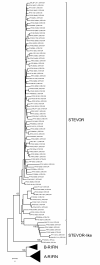RSpred, a set of Hidden Markov Models to detect and classify the RIFIN and STEVOR proteins of Plasmodium falciparum
- PMID: 21332983
- PMCID: PMC3050820
- DOI: 10.1186/1471-2164-12-119
RSpred, a set of Hidden Markov Models to detect and classify the RIFIN and STEVOR proteins of Plasmodium falciparum
Abstract
Background: Many parasites use multicopy protein families to avoid their host's immune system through a strategy called antigenic variation. RIFIN and STEVOR proteins are variable surface antigens uniquely found in the malaria parasites Plasmodium falciparum and P. reichenowi. Although these two protein families are different, they have more similarity to each other than to any other proteins described to date. As a result, they have been grouped together in one Pfam domain. However, a recent study has described the sub-division of the RIFIN protein family into several functionally distinct groups. These sub-groups require phylogenetic analysis to sort out, which is not practical for large-scale projects, such as the sequencing of patient isolates and meta-genomic analysis.
Results: We have manually curated the rif and stevor gene repertoires of two Plasmodium falciparum genomes, isolates DD2 and HB3. We have identified 25% of mis-annotated and ~30 missing rif and stevor genes. Using these data sets, as well as sequences from the well curated reference genome (isolate 3D7) and field isolate data from Uniprot, we have developed a tool named RSpred. The tool, based on a set of hidden Markov models and an evaluation program, automatically identifies STEVOR and RIFIN sequences as well as the sub-groups: A-RIFIN, B-RIFIN, B1-RIFIN and B2-RIFIN. In addition to these groups, we distinguish a small subset of STEVOR proteins that we named STEVOR-like, as they either differ remarkably from typical STEVOR proteins or are too fragmented to reach a high enough score. When compared to Pfam and TIGRFAMs, RSpred proves to be a more robust and more sensitive method. We have applied RSpred to the proteomes of several P. falciparum strains, P. reichenowi, P. vivax, P. knowlesi and the rodent malaria species. All groups were found in the P. falciparum strains, and also in the P. reichenowi parasite, whereas none were predicted in the other species.
Conclusions: We have generated a tool for the sorting of RIFIN and STEVOR proteins, large antigenic variant protein groups, into homogeneous sub-families. Assigning functions to such protein families requires their subdivision into meaningful groups such as we have shown for the RIFIN protein family. RSpred removes the need for complicated and time consuming phylogenetic analysis methods. It will benefit both research groups sequencing whole genomes as well as others working with field isolates. RSpred is freely accessible via http://www.ifm.liu.se/bioinfo/.
Figures




Similar articles
-
STRIDE: a command-line HMM-based identifier and sub-classifier of Plasmodium falciparum RIFIN and STEVOR variant surface antigen families.BMC Bioinformatics. 2022 Jan 6;23(1):15. doi: 10.1186/s12859-021-04515-8. BMC Bioinformatics. 2022. PMID: 34991452 Free PMC article.
-
Whole genome sequencing and microsatellite analysis of the Plasmodium falciparum E5 NF54 strain show that the var, rifin and stevor gene families follow Mendelian inheritance.Malar J. 2018 Oct 22;17(1):376. doi: 10.1186/s12936-018-2503-2. Malar J. 2018. PMID: 30348135 Free PMC article.
-
Diamonds in the rif: Alignment-free comparative genomics analysis reveals strain-transcendent Plasmodium falciparum antigens amidst extensive genetic diversity.Infect Genet Evol. 2025 Apr;129:105725. doi: 10.1016/j.meegid.2025.105725. Epub 2025 Feb 5. Infect Genet Evol. 2025. PMID: 39920908 Free PMC article.
-
The varieties of gene amplification, diversification and hypervariability in the human malaria parasite, Plasmodium falciparum.Mol Biochem Parasitol. 2009 Aug;166(2):109-16. doi: 10.1016/j.molbiopara.2009.04.003. Epub 2009 Apr 16. Mol Biochem Parasitol. 2009. PMID: 19375460 Review.
-
STEVOR--a multifunctional protein?Mol Biochem Parasitol. 2004 Mar;134(1):11-5. doi: 10.1016/j.molbiopara.2003.09.011. Mol Biochem Parasitol. 2004. PMID: 14747138 Review.
Cited by
-
Dissecting the Gene Expression, Localization, Membrane Topology, and Function of the Plasmodium falciparum STEVOR Protein Family.mBio. 2019 Jul 30;10(4):e01500-19. doi: 10.1128/mBio.01500-19. mBio. 2019. PMID: 31363031 Free PMC article.
-
Design of a variant surface antigen-supplemented microarray chip for whole transcriptome analysis of multiple Plasmodium falciparum cytoadherent strains, and identification of strain-transcendent rif and stevor genes.Malar J. 2011 Jun 30;10:180. doi: 10.1186/1475-2875-10-180. Malar J. 2011. PMID: 21718533 Free PMC article.
-
Variant surface antigens of Plasmodium falciparum and their roles in severe malaria.Nat Rev Microbiol. 2017 Aug;15(8):479-491. doi: 10.1038/nrmicro.2017.47. Epub 2017 Jun 12. Nat Rev Microbiol. 2017. PMID: 28603279 Review.
-
Analysis of subtelomeric virulence gene families in Plasmodium falciparum by comparative transcriptional profiling.Mol Microbiol. 2012 Apr;84(2):243-59. doi: 10.1111/j.1365-2958.2012.08019.x. Epub 2012 Mar 22. Mol Microbiol. 2012. PMID: 22435676 Free PMC article.
-
STRIDE: a command-line HMM-based identifier and sub-classifier of Plasmodium falciparum RIFIN and STEVOR variant surface antigen families.BMC Bioinformatics. 2022 Jan 6;23(1):15. doi: 10.1186/s12859-021-04515-8. BMC Bioinformatics. 2022. PMID: 34991452 Free PMC article.
References
Publication types
MeSH terms
Substances
LinkOut - more resources
Full Text Sources
Other Literature Sources
Molecular Biology Databases
Research Materials

